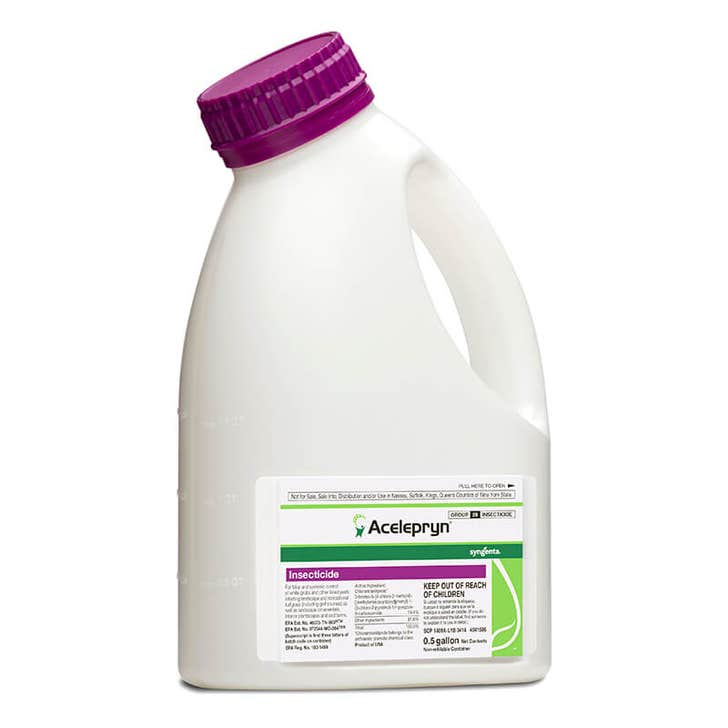We use cookies to make your experience better. To comply with the new e-Privacy directive, we need to ask for your consent to set the cookies. Learn more
Syngenta - Acelepryn Insecticide
- Season-long control of key turf-damaging white grub species
- Season-long control of caterpillars including black cutworms, sod webworms and fall armyworms
- Excellent billbug and annual bluegrass weevil control
- Flexibility to allow rainfall to move the product into the soil or irrigate after application
- No known adverse effects on beneficial and non-target organisms including earthworms and honeybees
Product Details
Acelepryn Insecticide Gives You Far More Than Unsurpassed Grub Performance
Powered by the active ingredient chlorantraniliprole, Acelepryn insecticide provides season-long grub control with a single application in April or May. But that same application of Syngenta insecticide Acelepryn will control many key surface feeding pests.
Trust the Smartest Choice to Protect Your Lawns Against Insects
Throughout the year, your lawn and surrounding areas are susceptible to insects that can lurk beneath the surface, waiting to feed on the roots of your grass. You may not be aware of them until your lawn is already injured. However, the most common damaging pests like grubs, turf caterpillars, and more can be controlled before it is too late.
To control insects in your yard, use a different approach that is effective against threatening insects while also being sensitive to beneficial insects. Syngenta Acelepryn insecticide provides the best season-long protection against grubs, turf caterpillars, and more while being gentle on the environment and safeguarding the biodiversity surrounding your lawn.
Acelepryn insecticide provides the best results when applied early. The wide application window allows superintendents the flexibility to apply when the timing is right for them.
Active Ingredient: Chlorantraniliprole
Use Sites:
- Golf Courses
- Residential and Commercial Lawns
- Ornamental Gardens
- Playgrounds
- Athletic Fields
- See Acelepryn label for complete list
Pests Controlled:
- Cutworms
- Sod Webworms
- White Grubs
- Japanese Beetle
- Chinch Bugs
- Annual Bluegrass Weevil
- See Acelepryn label for complete list
Application:
Do not apply this product in commercial nurseries or greenhouses. Do not apply within 25 feet of a water body. See label for complete details and application instructions.
How does it work?
- Once applied, the treatment moves into the soil and roots and up into the plant stem, protecting your turf from insects below the surface that you cannot see.
- One application in the spring provides season-long protection from white grubs, billbugs, and turf caterpillars.
- Unlike most other products, it is not required for your lawn to be irrigated or rained on after treatment is applied.
Best Practices for Application-
- Minimizing thatch accumulation will aid Acelepryn in reaching the target insect.
- Avoid mowing treated area until irrigation or rainfall has occurred.
- The higher application rate may be required where a long residual is desired.
Understanding Damage from Grubs and Other Troublesome Lawn Pests
Did you know if your lawn had grub damage last year, it has an 80% chance of being damaged by grubs again? Get ahead of the nuisance and get a yard that thrives all season when you include just one application of Syngenta Acelepryn in your lawn treatments.
What is a grub?
- A white grub is the immature or larval stage of beetles such as Japanese beetles, masked chafers, and green June beetles.
- When dug up from the soil, grubs are “C” shaped, grayish white in color with brown heads.
- Adult beetles lay eggs in the soil that develop into larvae and live in the soil where they feed on the roots of your grass until they emerge as adults.
- Grubs grow and feed below the surface of your lawn, so you may not be aware of them until it is too late and you see the damage they have caused.
- Grub damage to roots reduces your lawn’s ability to take up water and nutrients needed to be healthy.
What does grub damage look like?
- Yellowing grass often pulls up easily because the roots are not anchored.
- Scattered, irregular dead spots.
- Dry brown spots look like drought damage, fertilizer burn, or disease.
What about other insects besides grubs?
Along with controlling grubs, Acelepryn insecticide can also protect your lawn from additional insects, including billbugs and turf caterpillars. While less common than white grubs, these insects can still cause substantial turf damage.
- Billbug larvae feed inside the grass stem then drop to feed on the base and roots of the grass.
- Billbug damage results in scattered yellowish patches that usually appear in late June through early August.
- Caterpillar damage results in brown patches that rapidly increase in size.
- Known for munching on almost every type of grass, turf caterpillars can cause severe damage one blade at a time.
- The most common surface-feeding caterpillars on home lawns are armyworms and sod webworms. Almost all lawn damage is caused by the larger caterpillar larvae of adult moths that feed on leaf tissue.
Specifications
Resources & Videos

